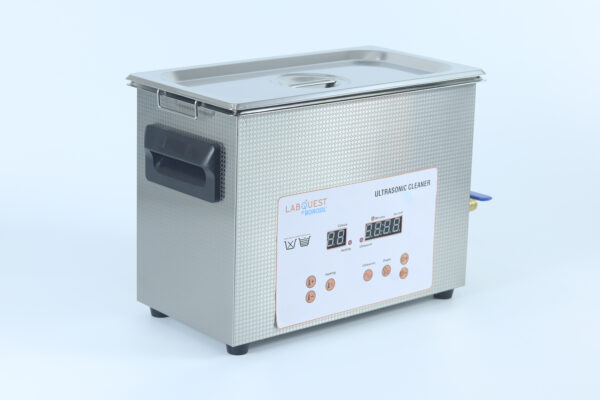Improve Laboratory Efficiency with Our Ultrasonic Bath Sonicator for Precise Cleaning
Efficiency and precision are two important aspects of a well-functioning laboratory. Contaminant-free equipment is crucial whether you’re a researcher working on groundbreaking experiments or a technician handling routine sample preparation. This is where the ultrasonic bath comes in—a device revolutionising laboratory cleaning practices by delivering precise and efficient results. Let’s see how an ultrasonic laboratory water bath can transform your laboratory’s cleaning process, ensuring accuracy, saving time, and enhancing overall productivity.
What is an Ultrasonic Bath Sonicator, and Why is it Essential?
An ultrasonic bath uses high-frequency sound waves in a liquid medium to clean objects, primarily small and intricate lab tools. Unlike traditional cleaning methods, which can leave residue in hard-to-reach areas, this innovative approach ensures deep and thorough cleaning.
- How it works: The sonicator generates sound waves at frequencies around 40kHz, creating microscopic bubbles in the cleaning solution. These bubbles implode upon contact with surfaces, removing contaminants such as grease, residues, and particles without damaging the items.
- Why you need it: Whether you’re cleaning pipettes, test tubes, or glass slides, the ultrasonic bath minimises cross-contamination, a critical factor for reliable experimental outcomes.
Key Benefits of Using an Ultrasonic Bath in Laboratories
Today’s ultrasonic baths are so much more advanced than their early prototypes. They have advanced features that make them indispensable in any modern laboratory setup. Below are some standout benefits.
- Enhanced Cleaning Efficiency: The primary advantage of an ultrasonic bath is its ability to clean thoroughly and quickly, reducing the time laboratory staff spend on manual cleaning.
- Safety and Delicacy in Handling: Traditional cleaning methods can be abrasive. In contrast, ultrasonic cleaning is gentle enough to handle delicate instruments, reducing the risk of damage during the cleaning process.
- Chemical Usage Reduction: This technology requires less chemical use than other cleaning methods, promoting a safer, more environmentally friendly laboratory environment.
- Cross-contamination Prevention: Ensuring no residue or contaminant is left behind from previous cleaning cycles is crucial in labs. Ultrasonic cleaning minimises this risk effectively.
Efficient Cleaning Protocols Using Ultrasonic Baths
Implementing an ultrasonic bath in laboratory cleaning protocols can drastically improve the efficiency and effectiveness of the cleaning processes. Here’s how a typical cleaning session might be structured:
- Preparation: Ensure all instruments are pre-rinsed to remove loose contaminants.
- Setting Up: Place instruments in the SS Mesh Basket, ensuring they are fully submerged in the cleaning solution.
- Choosing the Right Cycle: Select the appropriate cleaning cycle based on the type of contaminants and the delicacy of the instruments. Here are the various operation cycles:
Light Cleaning: 5–10 minutes
Moderate Cleaning: 10–20 minutes
Heavy Cleaning: Up to 30 minutes
Max Cycle Duration: 45 minutes (varies by model)
Cooling Period: 15–30 minutes after long cycles
Important: Avoid continuous use beyond 1 hour; check the manual for duty cycle limits.
- Post-Cleaning: After the cycle, instruments should be rinsed with distilled water to remove any traces of the cleaning solution, then dried and stored properly.
Managing Temperature Rise During Sonication
Ultrasonic baths generate heat even when the heating element is off, as ultrasound waves cause localised heating. Prolonged operation, high power output, and longer sonication times can lead to excessive temperature rise, affecting performance and equipment longevity.
Factors Affecting Temperature Rise
- Power Output: Higher power increases energy transfer and heat buildup.
- Frequency (20–40 kHz): Higher frequencies enhance cavitation, raising temperature.
- Water Volume: Larger volumes heat up slower than smaller ones.
- Sonication Duration: Longer operation leads to greater heat accumulation.
- Initial Temperature: Cooler water delays heating, while warmer water accelerates it.
Practical Solutions to Manage Temperature
Here are the practical solutions to manage this temperature rise:
- Add Cold Water: Replace hot water periodically during long runs.
- Intermittent Sonication: Use pulsed cycles to allow heat dissipation.
- Stirring: Ensures even heat distribution and prevents hotspots.
- Limit Usage: Operate for max 45 mins, then cool for 20 mins.
- Cooling Systems: Use water baths with cooling mechanisms for temperature control.
Always follow the manufacturer’s guidelines to ensure safe and efficient operation.
Applications of Ultrasonic Bath Sonicators in Laboratories
The versatility of ultrasonic baths extends their utility across a wide array of laboratory environments. Here’s how they are applied in various fields:
- Biomedical Laboratories: In these settings, ultrasonic laboratory water baths are crucial for cleaning surgical instruments to maintain sterility. They also remove biological residues from sensitive equipment, essential for preventing cross-contamination and ensuring patient safety.
- Pharmaceutical Research: Ultrasonic baths play a pivotal role in the pharmaceutical sector by preparing and cleaning drug-testing equipment, thus safeguarding the integrity of drug trials. They also ensure the precise cleaning of glassware used for analytical tests, which is critical for obtaining accurate results.
Cost-Effectiveness and ROI
Investing in an ultrasonic bath can lead to significant cost savings in the long run. By reducing the time spent on manual cleaning and the need to replace delicate instruments due to less damage during cleaning, laboratories can achieve a better return on investment.
Conclusion
Laboratories demand precision at every step, and an ultrasonic bath sonicator bridges the gap between thorough cleaning and operational efficiency. Its applications, benefits, and features make it an indispensable tool in any laboratory, academic, research, or industrial laboratory. If you’ve been relying on outdated cleaning methods, now is the time to upgrade your processes with this modern instrument by choosing leading brands like Borosil Scientific. Clean smarter, work better, and achieve the results your work truly deserves.
Read More From Techbullion



































